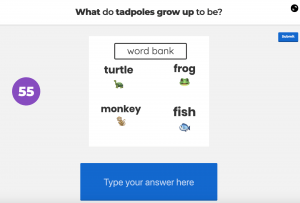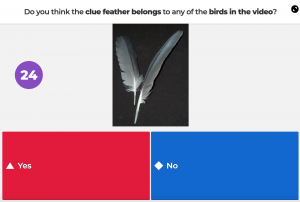Assessment 4 Part A
Part B: Game Project- Intruder in the Science Lab!
Context

The chosen context for this Game-based learning project was a first-grade cohort within an American curriculum International School located in South Korea. 95% of the cohort speak English as an Additional Language (EAL). Currently, the main mode of instruction is through online learning and this is taken into account for the design and use of this project. The students are familiar with the chosen platform for design; Kahoot. To reach students in the distance learning environment the Starter Guide to Distance Learning with Kahoot! (2020) was helpful.
Learning Outcomes
The subject area focus of the game is primarily on Science with some crossover into literacy and mathematics. The main purpose of this game is for students to build on skills and ideas already explicitly taught to strengthen their working knowledge of living organisms and their key vocabulary. The storyline and its questions will prompt students to use all they know about the structure and function of living things. The overview of the learning outcome from the curriculum is:
“Students are expected to develop an understanding of how plants and animals use their external parts to help them survive, grow, and meet their needs as well as how behaviors of parents and offspring help the offspring survive” (Next Generation Science Standards. 2020a, p. 6).
As a part of the Science and Engineering practices of this curriculum students who demonstrate understanding can obtain, evaluate and communicate information that builds from prior experiences and uses observations and texts to communicate new information (Next Generation Science Standards, 2020b).
In summary, the two main learning outcomes of the game are for students to show their understanding of specific science concepts relating to lifecycles and living organisms and the ability to obtain, evaluate and communicate this information effectively.
Game Design
The game was designed on the Kahoot! platform which primarily takes a quiz; question and answer, format. This appeared to have a few limitations in the beginning. In order to “gamify” within the boundaries of this platform, a mix of pragmatic and scripted pedagogical approaches to game-based teaching (Hanghøj, 2013) was taken during the design. The game’s narrative allowed it to become a simulation in which students are asked to help solve a problem in a mockup situation within their school science lab.
It was because of this storyline that the design of the game then allowed for more of an immersive flow. Gee (2003) infers that when virtual contexts are familiar content knowledge can be transferred with more relevance. There is also emotional involvement as a factor (Gee, 2003) as the students have a relationship with the teacher who is directly affected by the narrative posed problem.
Another key characteristic in terms of motivation is the use of competition with the points system (Wood, Chappell, Davies, & Mark, 2004). The game was designed to be playable in an online context, however, the in-class play could include collaboration in teams or partners and therefore a chance for dialogue and vocabulary practice in real-time. This is a learning target for the context. The in-class option has the ability for higher stakes competition which could also provide a higher level of motivation for the players.

EAL teaching strategies have been embedded in the design of the game. Benoit (2017) tells us that receptive language learning is the foundation EALs need before they can begin to develop their production of language. The word knowledge understanding that students develop is gained through listening and more importantly reading (Benoit, 2017). Some key strategies in the game for EAL students are the use of bold keywords, the use of images to accompany writing for multi-choice questions, and a word bank when an open-ended question is posed. English learning in game-based environments could help to ease anxieties faced by EAL students in traditional settings by letting students learn at their own pace and access more adaptive learning content (Hwang, Hsu, Lai & Hsueh, 2017).

In regard to the age of the primary audience certain developmentally friendly teaching strategies were used such as the length of the videos were shortened to hold interest and make the specific information easily understandable to prepare for the next level of the game. User-experience of the audience was taken into account by the use of the familiar Kahoot platform. Also, ample time is given for questions to be answered, however, the timer still provides excitement and pressure as another aspect of the gaming experience.
While most of the questions and answers are designed to be easily answered one of the questions is designed to be a “trick question” which students are most likely to answer incorrectly. This was done purposefully as it relates to punishment being a motivator to do well again as put forward by Wood et. al (2004).

Some limitations of the game design include the opportunity for collaboration as already mentioned previously. It depends on whether the game is used online for distance learning or in class with peers. Player identity; as a fictional character, and an element of fantasy is also lacking. The players remain themselves, the students in the Science lab within a real-world situation. However, fantasy could be viewed as arbitrary and these fantasy worlds could easily be changed to another if the basic game processes are kept the same (Habgood & Ainsworth, 2011).
Lastly, as Kahoot can be seen as a linear quiz-based game learning tool, a more open-ended, exploratory gaming platform might be explored in the future. Higher-order thinking skills such as creating and evaluating are not engaged in linear games (O’Brien, 2011; Iowa State University, 2020) and these skills in the taxonomy could be utilized in a Role-Playing Game for the purpose of learning within this context and with these learning outcomes.
References
Benoit, J. (2017). The effect of game-based learning on vocabulary acquisition for middle school English language learners. In C. Clark, A. Lee, & C. Locklear (Eds.): ProQuest Dissertations Publishing.
Gee J. P. (2003). What video games have to teach us about learning and literacy. New York, NY: Palgrave Macmillan.
Habgood, M. P. J., & Ainsworth, S. E. (2011). Motivating children to learn effectively: Exploring the value of intrinsic integration in educational games. Journal of the Learning Sciences, 20(2), 169–206. http://dx.doi.org/10.1080/10508406.2010.508029
Hwang, G.-J., Hsu, T.-C., Lai, C.-L., & Hsueh, C.-J. (2017). Interaction of problem-based gaming and learning anxiety in language students’ English listening performance and progressive behavioral patterns. Computers & Education, 106, 26-42. doi:10.1016/j.compedu.2016.11.010
Iowa State University. (2020). Revised Bloom’s Taxonomy [Flash Version]. Retrieved from https://www.celt.iastate.edu/teaching/effective-teaching-practices/revised-blooms-taxonomy-flash-version/
Kahoot! (2020). Starter guide to distance learning with Kahoot! Retrieved on May 1, 2020, from https://kahoot.com/files/2020/05/DistanceLearningGuide_2020-05.pdf
Next Generation Science Standards. (2020a). Elementary Standards. Retrieved from https://www.nextgenscience.org/sites/default/files/K-2Topic.pdf
Next Generation Science Standards. (2020b). 1. Structure, Function, and Information Processing. Retrieved April 30, 2020, from https://www.nextgenscience.org/topic-arrangement/1structure-function-and-information-processing
O’Brien, D. (2011). A taxonomy of educational games. In Gaming and simulations: Concepts, methodologies, tools and applications (pp. 1-23). Hershey, PA: . doi:10.4018/978-1-60960-195-9.ch101
Wood, R. T. A. G., Chappell, M. D., Davies, D., & Mark N. O. (2004). The structural characteristics of video games: A psycho-structural analysis. CyberPsychology & Behavior, 7(1), 1–10.
